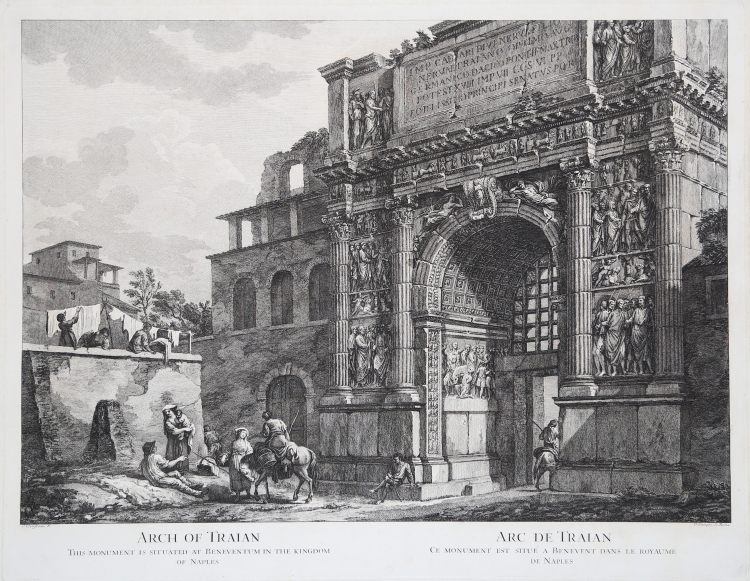



| Reference: | S46645 |
| Author | Domenico CUNEGO |
| Year: | 1760 ca. |
| Zone: | Benevento |
| Printed: | Rome |
| Measures: | 605 x 465 mm |


| Reference: | S46645 |
| Author | Domenico CUNEGO |
| Year: | 1760 ca. |
| Zone: | Benevento |
| Printed: | Rome |
| Measures: | 605 x 465 mm |
The arch of Trajan at Benevento, after Charles Louis Clérisseau, with some figures seen hanging the laundry on a terrace in the left foreground, and below some figures chatting.
Etching, circa 1760/65, lettered with title followed by 'this monument is situated at Beneventum in the Kingdom of Naples', in English and French, and production details: 'C. Clerisseau p. / D. Cunego sc. Romae'.
From the series Views of Antique Buildings and Famous Ruins in Italy.
Charles-Louis Clérisseau (28 August 1721 – 9 January 1820) was a French architect, draughtsman, antiquary, and artist who became a leading authority on ancient Roman architecture and Roman ruins in Italy and France. With his influence extending to Russia, England, and the United States, and clients including Catherine the Great and Thomas Jefferson, Clérisseau played a key role in the genesis of neoclassical architecture during the second half of the 18th century.
Clérisseau created works on paper using a variety of media, often in combination, including pencil, chalk, ink, watercolor, and gouache. Many of his works were reproduced as etchings by engravers including Domenico Cunego (the series Views of Antique Buildings and Famous Ruins in Italy), Francesco Bartolozzi, Francesco Zucchi and Paolo Santini.
Central to the engraver Domenico Cunego (Verona 1727 - Rome, 1803) was his meeting in 1760 with James Adam, who stopped in Verona from about October 9 to 20 in the company of Clérisseau, Abbot Farsetti and one of the Zucchi brothers, and hired a draughtsman, Giuseppe Sacco, as his servant and, as engraver, Cunego, who apparently had been introduced to him by Count Girolamo Dal Pozzo. The Views of Antique Buildings and Famous Ruins in Italy refer to a larger project of Antiquities of Sicily and Graecia Major, discussed at length with Clérisseau and set up between September and December 1761 during a trip to the Naples area in which Cunego does not appear to have participated in person.
A very good impression, on contemporary laid paper, with small margins, trace of glue on verso, otherwise in good condition. Rare.
Bibliografia
Gian Luca Kannès, Domenico Cunego, in “Dizionario Biografico degli Italiani” - Volume 31 (1985).
Domenico CUNEGO (Verona, 1724 o 1725 – Roma, 8 gennaio 1803)
|
Cunego was born in Verona. Having studied under the otherwise-unknown painter Francesco Ferrari, he began his artistic career as a painter, producing several works, all of which are now lost or untraceable. At age 18, however, he switched to engraving (a field in which he was possibly self-taught). He died in Rome.
The engravings he made depicting Michelangelo's Sistine Chapel ceiling, published in Gavin Hamilton's Schola Italica Picturae (1773), were an important source for the artists of his time. He is notable not only for reproducing paintings by his famous fellow-countrymen like Guido Reni and Italian contemporaries such as Antonio Balestra, Francesco Solimena, and Felice Boscaratti, but also works by British artists in Italy catering to Grand Tourists. The latter included Gavin Hamilton's cycle of 6 works on the Iliad and David Allan's Origin of Portraiture.
His sons Luigi (b. 1750, d. 1823) and Giuseppe (b. 1760) were also engravers.
|
Domenico CUNEGO (Verona, 1724 o 1725 – Roma, 8 gennaio 1803)
|
Cunego was born in Verona. Having studied under the otherwise-unknown painter Francesco Ferrari, he began his artistic career as a painter, producing several works, all of which are now lost or untraceable. At age 18, however, he switched to engraving (a field in which he was possibly self-taught). He died in Rome.
The engravings he made depicting Michelangelo's Sistine Chapel ceiling, published in Gavin Hamilton's Schola Italica Picturae (1773), were an important source for the artists of his time. He is notable not only for reproducing paintings by his famous fellow-countrymen like Guido Reni and Italian contemporaries such as Antonio Balestra, Francesco Solimena, and Felice Boscaratti, but also works by British artists in Italy catering to Grand Tourists. The latter included Gavin Hamilton's cycle of 6 works on the Iliad and David Allan's Origin of Portraiture.
His sons Luigi (b. 1750, d. 1823) and Giuseppe (b. 1760) were also engravers.
|